HALF PRICE SALE ON EVERYTHING ENDS AT MIDNIGHT FRIDAY
NEW SEASON BARE ROOTS AT 50% OFF LAST SEASONS PRICES – ENDS 31 JULY
Menu
HALF PRICE SALE ON EVERYTHING ENDS AT MIDNIGHT FRIDAY
NEW SEASON BARE ROOTS AT 50% OFF LAST SEASONS PRICES – ENDS 31 JULY
 https://www.hopesgrovenurseries.co.uk/wp-content/uploads/2024/02/shutterstock_534476239-750x501.jpg
HEDGES FOR WINTER INTEREST
https://www.hopesgrovenurseries.co.uk/wp-content/uploads/2024/02/shutterstock_534476239-750x501.jpg
HEDGES FOR WINTER INTEREST
When autumn fades into winter, the structure of the garden becomes apparent, and hedges play a vital part. They may create a backdrop, or define a boundary, or they may subdivide a garden into separate areas. They’ll do it surprisingly quickly too. English yew, Taxus baccata, always cited as the slowest evergreen hedge of all, will form a shoulder-high hedge within eight years if it’s nurtured and fed. And it won’t cost the earth either because Hopes Groves Nurseries, in the Weald of Kent, can provide a range of home-grown plants lifted straight from the field. Planted now, young bare-root plants will establish quickly whether you want to help wildlife, inject some winter warmth, or scent the air. Larger specimens are also available, for an instant fix.
An Evergreen Infusion
It’s no wonder that our pagan ancestors worshipped the Green Man, because evergreen foliage makes the heart beat a little faster on a cold winter’s morning. The classic tall yew hedge, Taxus baccata, is ubiquitous for a reason, for this long-lived conifer is the only one capable of re-shooting from brown, dead-looking wood. It’s long-lived too and it only needs a once-a-year trim. August is the traditional month, although many gardeners trim into winter.
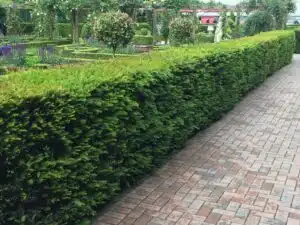
When planting any hedge, including yew, it’s important to prepare your ground a month or so beforehand so that it settles. Try to add some well-rotted garden compost to the bottom of the trench, if possible, because this will hold nutrients and moisture. Start with 4-year-old bare-root plants and soak them in water for a few hours before planting, but make sure that the ground isn’t frozen. If it is icy, heel your bare-root whips into the ground in a sheltered, frost-free spot until the weather improves.
Space yew whips a foot apart and then indulge them for the first year or two. Keep the weeds down and feed them during the growing season, between April and August, with a high-nitrogen plant food such as Growmore. Water your new hedge in dry spells but take note. Yew hates being waterlogged at the roots. This careful regime of weeding, watering, and feeding will encourage your new yew hedge to race away, once the roots get into the soil.
The most important thing about creating a yew hedge is knowing when to begin trimming it. Leave it to its own devices until it reaches five to six feet (roughly 2m) in height. Then cut a foot off the top in spring, to encourage bushy side growth. Hopes Grove sell a range of sizes, so you could make an instant yew hedge using 12ft-high ‘rootball’ hedging. Stick to the green English yew for hedging. The red fleshy covering on the fruit, known as the aril, is toxic to animals, although birds devour them.
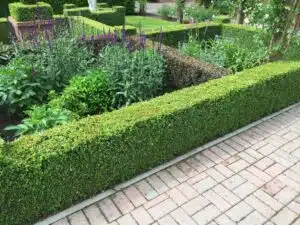
Box (Buxus sempervirens) is as fashionable as ever it was. It’s the classic, low evergreen hedge for parterres and sharp, tight topiary. It’s also being used to create free-form sculptures with cloud-cut contours. A once-a-year trim, between June until August, will keep it in trim. However, if you want a crisp winter silhouettes, a further autumnal trim is advisable. Box is a tough small-leaved evergreen, but it’s shallow-rooted, and best planted close together. A spacing of six to nine inches (15 – 22cm) is recommended and you can trim when young.
Box blight, usually called Cylindrocladium buxicola, has become a problem in recent years. It involves two or three fungal diseases, and, like all fungal diseases, it’s encouraged by warm, still and damp conditions. Airy gardens (like mine) rarely suffer. It’s important to buy healthy box plants with an outdoor provenance, like those from Hopes Grove Nurseries. Certain shapes are more prone to blight. Flat-topped box, cubes, and hedges, hold more water and suffer most. Topiarised pyramids of box shed water far more efficiently, due to their shape, and rarely suffer. Convex round balls are also less affected. When clipping box, it’s important to remove as many clippings as possible. Tedious, but necessary, and I prefer to clip in dull weather to avoid leaf scorch.
Box blight spores travel on wind-blown rain and on the air. The classic diagnostic is black streaks on the stems accompanied by die back. If you see it, cut away the infected areas and burn the twigs. Liquid seaweed feeds definitely toughen up the foliage and, should you be growing your box in containers, you will need to feed every 2 weeks during the growing season to prevent that unattractive metallic glint. Lots of gardeners swear by seaweed.
Some named forms of box are less-prone to blight. The award-winning Buxus microphylla ‘Faulkner’ has rounder green leaves, so this Japanese box has a gappier arrangement of foliage. ‘Rococo’, a dwarf box similar to ‘Faulkner’, is also more tolerant. The tastefully variegated form of box, B. sempervirens ‘Elegantissima’ is rarely affected by blight either. Like most variegated plants, it’s very drought-tolerant, so perfect for a hot, sunny position. Watch out for the white webs of box caterpillars as well. Destroy on site, preferably with a large boot. Always avoid chemical coshes where possible.
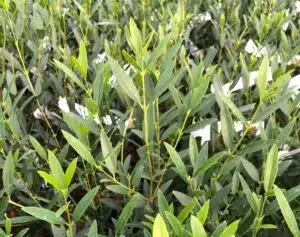 Gardeners are planting box lookalikes. Phillyrea angustifolia, once common in Victorian gardens, is making a comeback. This olive-like evergreen clips into roundels well. If you’ve a sheltered garden you might also plant the native New Zealand Greenleaf, Griselinia littoralis.
Gardeners are planting box lookalikes. Phillyrea angustifolia, once common in Victorian gardens, is making a comeback. This olive-like evergreen clips into roundels well. If you’ve a sheltered garden you might also plant the native New Zealand Greenleaf, Griselinia littoralis.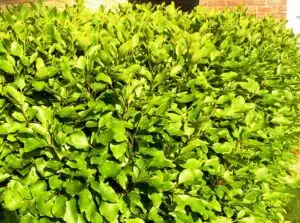
A Feast for Nature
More and more gardeners are planting for wildlife and a native hedge, whether it contains a fruitful mixture of species or just one, will provide an edible feast in autumn and winter. It will also offer much-needed nesting sites for birds. This has become far more important in recent years, because farm and roadside hedges are regularly scalped by brush cutters. Garden hedges help to fill the gap in available nesting sites, so they’ll bring birds into your garden too.
The best hedging plant for wildlife is our native hawthorn, Crataegus monogyna, because it could attract 149 species of insect in Britain. It’s fourth behind oak (284), willow (266) and birch (229). The red haws are favoured by migrant redwings and fieldfares, as well as various finches and robins. White cake-scented domes of blossom appear in May, earning hawthorn the common name of May. You’ll also get orange autumn foliage as temperatures drop.
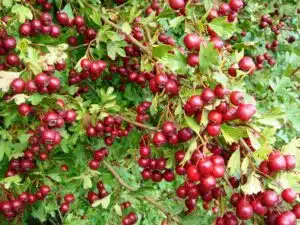
Blackthorn, Prunus spinosa, will produce a crop of sloes and the spindle, Euonymus europaeus, a carousel mixture of orange and vivid-pink. The latter bears the most nutritious fruit of all, and robins have been known to fight to the death, in order to stake their claim on a prized bush. Both of these jewel-like fruits tend to disappear before winter arrives, hopefully into the beaks of birds. Your mixed edible hedge could also contain dogwood, Cornus sanguinea, elder and hazel. Cut it into a A-shape after most of the fruit has gone.
Touches of Red
When it comes to garden hedges, the most accommodating holly is the rounder-leafed, less-prickly Highclere holly, Ilex x altaclerensis ‘Golden King’. It’s a female, despite its masculine epithet, and bears a crop of larger orange-red berries held above green and gold foliage. It’s faster growing than English holly, I. aquifolium, and much kinder to the fingers. It can be turned into lollipops, and it will form a hedge.
If you want crisp variegation and prickles, opt for the variegated English holly, Ilex aquifolium ‘Argentea Marginata’. The clusters of red berries nestle into the foliage and English holly will thrive underneath tall trees. Be aware though, if you’re shaping and pruning, you will sacrifice your berries.
There are other ways of adding a red infusion though, using foliage. Photinias, native to New Zealand, produce bright-red new shoots that glow in winter light. ‘Red Robin’ was the first, but the compact, waist-high ‘Little Robin’ soon followed. ‘Canivily’ (more commonly (and incorrectly) named ‘Camilvy’ in nurseries and online) is a deeper colour with upright narrow foliage in red-wine hues, or there are frosted forms such as ‘Pink Marble’ and ‘Louise’. A late-spring trim will produce vibrant new shoots.
Dogwoods also make fine statement hedging, as well as stand-alone specimens, and I’m a huge fan of Cornus sanguinea ‘Anny’s Winter Orange’ at every stage. Red stems and butter-orange foliage feature in autumn, as the green leaves fade. When they fall, the light show begins with twiggy stems that morph from warm-yellow up to fiery orange. Take a third out every year, once Anny’s established. You’ll get shades of coral-pink, orange and red with the equally twiggy ‘Midwinter Fire’.
There are thicker-stemmed dogwoods with red, green and black stems and these spread, but not-aggressively so, by producing stoloniferous roots. They don’t mind damp ground and their foliage develops to purple-red in autumn. These pencil-thick stems are strong enough to cut down to the base every April, but only after they’re established.
It’s quite possible to cast some fragrance in winter and I’d hand top marks to sarcococca, or sweet box, because the lily-like fragrance travels far and wide through the garden. If I had to choose one of many, it would be Sarcococca confusa, for its high-gloss green leaves, borne throughout the year, and early ivory-white flowers. It makes a waist-high hedge, without any clipping, and it’s perfect above an underplanting of hardy cyclamen, placed on the sunny side. Make sure that you have a garden seat nearby, to top up the Vitamin D and breathe in the divine scent!
Many of our customers buy topiary plants (and hedging plants) to grow in containers, one frequently asked question is how large does the pot that I plant them into need to be?
Expert horticultural advice on the merits and pitfalls of planting bare root yews, and how to get the best from them.
Pleached trees are a garden-design favourite, because they provide an instant leafy screen that looks stylish as soon as it’s planted. They offer privacy for you and they help to muffle noise and that’s becoming more important in our busy world. They provide a living screen that’s far more eco-friendly than a stark wooden fence…